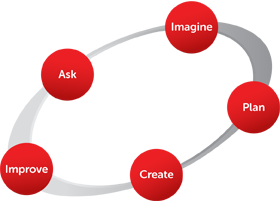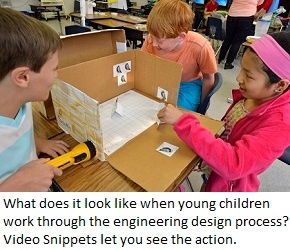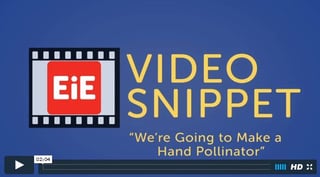 If you teach EiE, you can probably recite the five steps of the EiE Engineering Design Process (EDP) from memory: ASK – IMAGINE – PLAN – CREATE – IMPROVE!
If you teach EiE, you can probably recite the five steps of the EiE Engineering Design Process (EDP) from memory: ASK – IMAGINE – PLAN – CREATE – IMPROVE!
In our professional development workshops, however, we notice that educators who are new to classroom engineering sometimes can’t picture what these steps will look like when their students actually DO them. That’s one reason we created EiE Video Snippets. These super-short videos (most are about a minute long) show you, quickly and easily, how young children work through the five EDP steps.
Kids Are Asking Questions
 To see how this works, watch the Snippet “That’s a Good Question!” (right). Sandy Brown, a third-grade teacher in Fairfax, Vermont, introduces her students to the engineering design challenge from “Lighten Up: Designing Lighting Systems."
To see how this works, watch the Snippet “That’s a Good Question!” (right). Sandy Brown, a third-grade teacher in Fairfax, Vermont, introduces her students to the engineering design challenge from “Lighten Up: Designing Lighting Systems."
The children already learned how explorers in the 19th century used reflected light for illumination as they copied the art inside Egyptian tombs. Now, the students will design their own systems to light up a model tomb. They start the design process with the “ASK” step: What’s the problem you’re trying to solve? What are your criteria? What are your constraints?
 With a hands-on classroom activity like this, your instinct might be to start, not by ASKING, but by TELLING: “This is what you’re going to do, here’s how you’re going to do it, and here are your materials.” But the Snippet shows Sandy turning this model upside down, with great results.
With a hands-on classroom activity like this, your instinct might be to start, not by ASKING, but by TELLING: “This is what you’re going to do, here’s how you’re going to do it, and here are your materials.” But the Snippet shows Sandy turning this model upside down, with great results.
Notice the strategy she uses—and try it in your own classroom! She asks her students, “What do YOU want to know about the project?” Then, on a wall chart, she writes down their questions, without judgement or feedback.
You can literally see her third graders think deeply about the engineering challenge. Listen to their thoughtful questions as they explore what they need to know before they start the design work. This kind of exploration is the foundation of creative problem-solving.
Kids Are Wonderfully Creative
 We have other Snippets that illuminate the “ASK” step of the EDP . . . and all four other steps! To see first-grade students tackle the “CREATE” step of a sophisticated design challenge, watch the Video Snippet titled “We’re Going to Make a Hand Pollinator!”
We have other Snippets that illuminate the “ASK” step of the EDP . . . and all four other steps! To see first-grade students tackle the “CREATE” step of a sophisticated design challenge, watch the Video Snippet titled “We’re Going to Make a Hand Pollinator!”
You’ll see first-graders from teacher Julie Mock’s class in St. Elmo, MN working on the EiE unit “Best of Bugs.” They’re designing and testing hand pollinators, or devices that move pollen from one flower to another.
We often hear from workshop participants that this engineering challenge seems too sophisticated for very young children. Many adults have never heard of a hand pollinator, so how can little kids possibly design one?
Well, they can! You can tell from the children’s confident and happy attitudes that they fully understood the challenge, found it highly engaging, and are proud of the solutions they have designed.
- WATCH MORE: Browse EiE Video Snippets by EDP step
Do you have a question for EiE? Ask us! If we answer your question on the blog, we'll thank you by sending you the EiE Teacher Guide of your choice.
Engineering is Elementary is a project of the National Center for Technological Literacy® at the Museum of Science, Boston.








